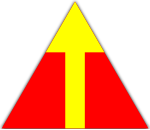17th Infantry Brigade (United Kingdom)
The 17th Infantry Brigade was an infantry brigade formation of the British Army which provided active service in the Second Boer War and both the First and Second World Wars. It was mainly composed of Regular Army battalions.
| 17th Brigade 17th Infantry Brigade | |
|---|---|
 17th Infantry Brigade Formation Sign. | |
| Active | 1914–1918 1939–1945 |
| Country | |
| Branch | |
| Type | Infantry |
| Size | Brigade |
| Part of | 8th Infantry Division 6th Infantry Division |
| Engagements | First World War Second World War |
| Commanders | |
| Notable commanders | Montagu Stopford Dudley Ward |
History
Second Boer War
During the Second Boer War, the 17th brigade was active in South Africa as part of the 8th Division from early 1900 until the war ended in 1902.[1] It was under the command of Major-General John Edward Boyes, and included the following battalions:
- 2nd Battalion Manchester Regiment, 1st Battalion South Staffordshire Regiment, 1st Battalion Worcestershire Regiment, 2nd Battalion West Kent Regiment
First World War
The 17th Brigade was originally part of the 6th Division during the First World War,[2] The commander was Brigadier General W.R.B. Doran CB DSO on mobilisation.[3] It was transferred to the 24th Division, a New Army division, on 14 October 1915.[2] The brigade saw service mainly on the Western Front.[2]
Component Units in World War I
On mobilisation - August 1914
Component units included:[2]
- 1st Battalion, Royal Fusiliers (City of London Regiment)
- 1st Battalion, Prince of Wales's (North Staffordshire Regiment)
- 2nd Battalion, Prince of Wales's Leinster Regiment (Royal Canadians)
- 3rd Battalion, Rifle Brigade (Prince Consort's Own)
November 1918
Component units included:[4]
- 8th (Service) Battalion, Queen's (Royal West Surrey Regiment)
- 1st Battalion, Royal Fusiliers (City of London Regiment)
- 3rd Battalion, Rifle Brigade (Prince Consort's Own)
- 17th Trench Mortar Battery
Second World War
The Brigade served with the 5th Infantry Division through most of the Second World War.[5] On 5 May 1942 it was part of Force 121 in the invasion of Madagascar.[5] After this, the 17th Infantry Brigade served in the invasion of Sicily with the British Eighth Army and the Italian Campaign before taking part in the closing stages of the campaign against Germany.[5]
Component Units in World War II
Component units included:[6]
- 2nd Battalion, Royal Scots Fusiliers
- 2nd Battalion, Northamptonshire Regiment
- 2nd Battalion, Seaforth Highlanders (to 30 March 1940)
- 6th Battalion, Seaforth Highlanders (from 30 March 1940)
- 156th (Lanarkshire Yeomanry) Field Regiment, Royal Artillery
References
- "Anglo-Boer War".
- "The 6th Division in 1914-1918". The Long, Long Trail. Retrieved 22 August 2015.
- Major General T.O. Marden, ed. (1920). A Short History of the 6th Division.
- "The 24th Division in 1914-1918". The Long Long Trail. Retrieved 9 February 2015.
- "badge, formation, 5th Infantry Division". Imperial War Museum. Retrieved 22 August 2015.
- Joslen, H. F. (2003) [1990]. Orders of Battle: Second World War, 1939–1945. Uckfield: Naval and Military Press. p. 259. ISBN 978-1-84342-474-1.